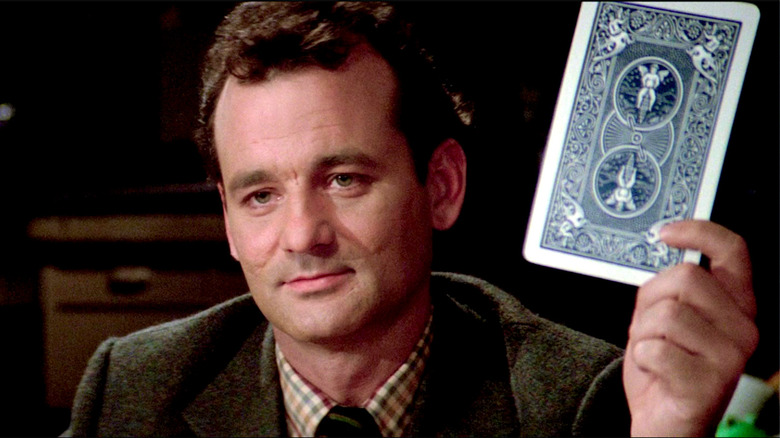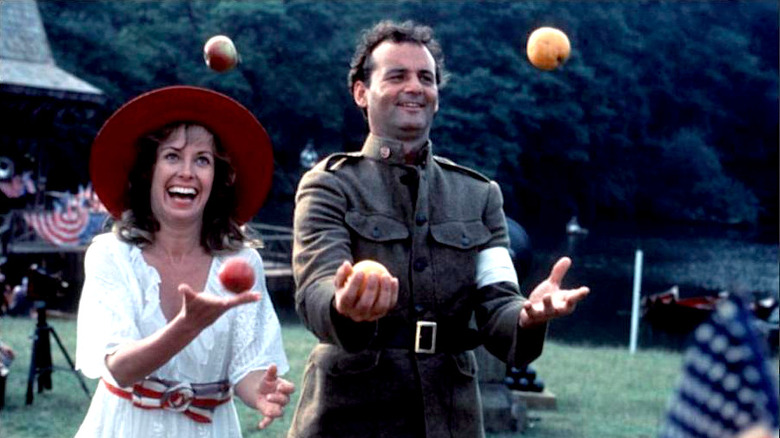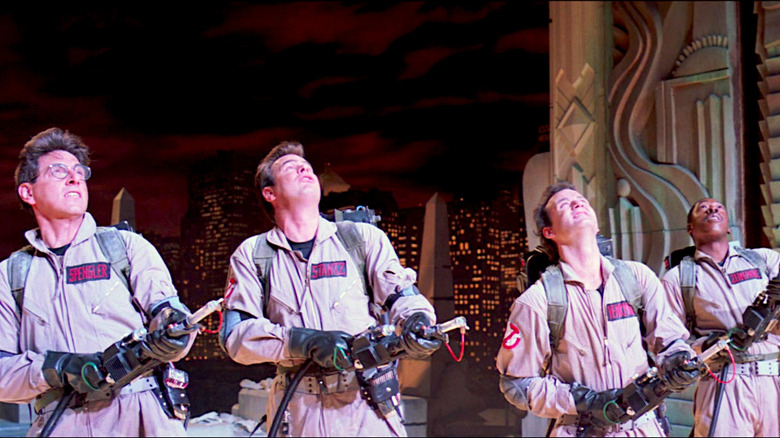Bill Murray Had An Ulterior Motive For Taking His Ghostbusters Role
Bill Murray is a man with an illustrious acting career. He's done everything from taking on the role of the gopher-obsessed groundskeeper Carl Spackler in "Caddyshack" to decidedly more serious roles like washed up movie star Bob Harris in "Lost in Translation." He's got the range and the talent to deliver his quintessential deadpan humor one minute, only to pivot to a more raw, vulnerable side the next.
One of Murray's most serious roles is that of Larry Darrell in the 1984 adaptation of W. Somerset Maugham's story, "The Razor's Edge." In the film, Murray plays a World War I veteran whose life is considerably altered after his commanding officer gives his life to save Larry's. Reeling from survivor's guilt, Larry embarks on a multi-country search for meaning as he struggles to understand his purpose in the world. It is a devastating story and not one that is frequently referenced when talking about Murray and his most famous works. Surprisingly, it also played an important role in the production of another extremely famous Bill Murray film — "Ghostbusters."
That's right, everyone's favorite ghost-busting team owes a little bit of its existence to Murray's deep devotion to making "The Razor's Edge."
What do Slimer and World War I have in common?
The way Bill Murray got involved with the production of "The Razor's Edge" goes like this: One day, the director of the film, John Byrum, visited his friend Margaret Kelly in the hospital. She had just given birth, and he had come to visit and deliver a book, "The Razor's Edge," (because that's the book you want to read after just having had a baby!). Byrum was hoping to film his version of the story, but he needed a place to start. Thankfully, the starting point came in the form of Bill Murray, then-husband to Kelly, who called Byrum up right away telling him he was interested in getting involved. He allegedly greeted Byrum on the phone by saying, "This is Larry, Larry Durrell," the book's main character. From that point on, the deal was set and Byrum and Murray set off on a road trip across America (insert your favorite Jack Kerouac reference here) to write the script. Unfortunately, upon their return they found that no one was really that interested in making their movie a reality.
In an interview for Rolling Stone, Murray explains how he was finally able to convince Hollywood to make his and Byrum's film, "Dan Aykroyd called me up with this 'Ghostbusters' idea, and I said, 'Yeah, this is great.' He sent me about seventy-five pages, and within an hour there was a deal," Murray says. Fairly soon after, all the major studios were trying to get their hands on the "Ghostbusters script." Seeing his opportunity, Murray decided to try and strike a deal. He told Aykroyd that he was hoping to finish "The Razor's Edge" before committing to another project but was having trouble generating any interest. Aykroyd suggested using "The Razor's Edge" as a bargaining chip, telling Murray to inform Columbia studios that the films were a packaged deal of sorts. If they wanted to make "Ghostbusters," they were going to have to make "The Razor's Edge," as well. Not wanting to lose out on "Ghostbusters" — I mean, it's "Ghostbusters!" — the studio agreed, and "A Razor's Edge" began shooting.
The trouble with moving between dimensions
Because the two movies are so drastically different from each other (one is a devastating portrait of the aftereffects of war, while the other involves, well, slimy ghosts and a giant marshmallow man), it was hard for Murray to shift easily between the two mindsets required to make the films work. Columbia Pictures was eager to get started on "Ghostbusters," but Murray was exhausted from filming "The Razor's Edge" in India. He told Rolling Stone, "I wanted to take 10 days off. I was so tired that I couldn't even get out of the hotel room in Delhi for four or five days. I didn't really do anything except sleep," but Columbia was adamant that he return as soon as possible to start bustin' ghosts and gettin' slimed.
When Murray eventually made it onto the set of "Ghostbusters," he found himself disoriented by the stark contrast between India where much of "A Razor's Edge" was filmed and Hollywood. He said, "I kept thinking to myself, '10 days ago I was up there working with the high lamas in a gompa, and here I am removing ghosts from drugstores and painting slime on my body.'" Ironically, the major differences between India and America's Hollywood caused Murray to have his own "Razor's Edge" inspired internal conflict. "It was kind of tough to get into it for about a month." he said, questioning why he was even there on the set of "Ghostbusters" in the first place.
Eventually, Murray readjusted to the Hollywood way of things and was able to go on to shoot the rest of "Ghostbusters" without issue. Well, perhaps for Murray himself, but for Dr. Peter Venkman and the rest of the crew? It was going to take a lot of focus and proton pack energy to get Zuul back where the god rightfully belonged.


